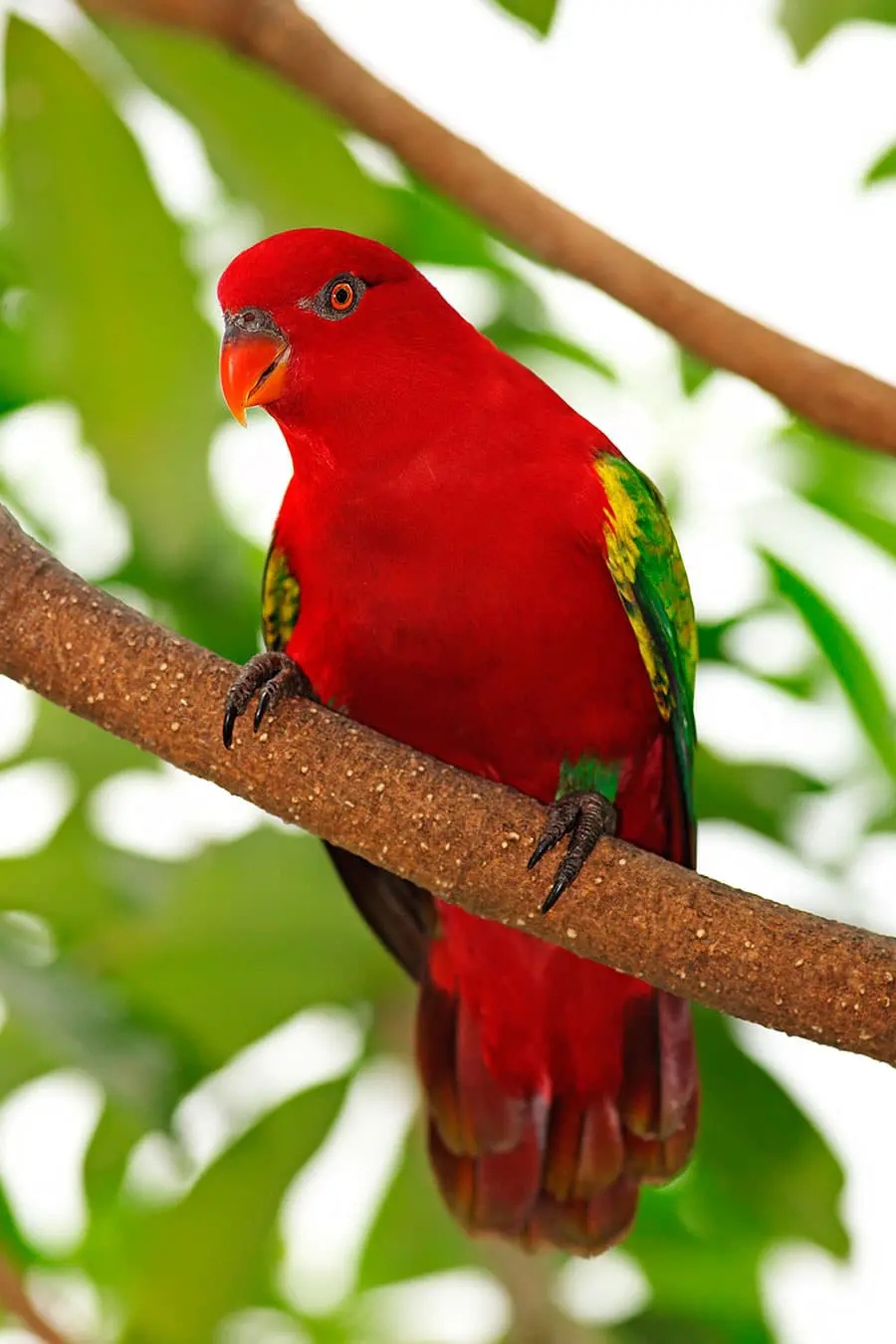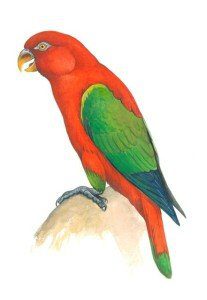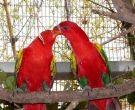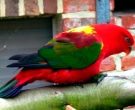Content |
|---|
Description
30 cm.. length and a weight between 180 and 250 g..
The Chattering Lory (Lorius garrulus) has the head, the nape and the the mantle top of color Scarlet bright. Great stain yellow in the center of the the mantle surrounded above and below a light spread of green opaque; scapulars Scarlet, a little darker than the the mantle; rump and top of the tail, bright Scarlet.
the flight feathers green up; coverts a little more pale and with a vague diffusion in bronze. The great coverts a dark gray at their ends; the alula Blackish green with yellow spot in the bend of wing and along the edge of the carpus.
The bottom of the flight feather of color black with band broadband of color tints in the Center, the coverts yellowish green. Underparts bright Scarlet; green thighs. The feathers of the tail red, with the black end fade Green. The bill orange; irises Orange to yellowish brown; legs grisaceo-negro color.
Both sexes are equal.
Immature with the bill brown, and the irises dark brown.
Description and distribution of subspecies
-
Lorius garrulus garrulus
(Linnaeus, 1758) – (Halmahera, the Widi Islands and Ternate) The nominal
-
Lorius garrulus flavopalliatus
(Salvadori, 1877) – (Bacan and OBI) Large yellow patch in the the mantle with much less greenish broadcasting.
-
Lorius garrulus morotaianus
(Bemmel, 1940) – (Morotai and Riau) Small yellow patch in the mantle of green-dyed.
- Sound of the Chattering Lory
Habitat:
Though White and Bruce they say the species is common in coastal lowlands with coconut palms, recent observations seem to point to forested areas of high land as their main habitat. It is unclear if the capture is responsible for the apparent absence of their previously preferred habitat. Seasonal movements or nomadic behavior could also be factors for this absence from the coastal lowlands.. The Chattering Lory they occur more often in mature primary and secondary forests, far from human settlements from the lowlands up to 1.300 m.
They are usually in pairs, and are noisy and visible in flight but, like many other parrots, can become difficult to spot when feeding quietly in the forest canopy.
Reproduction:
Little is known about the reproduction of the species in the wild. A couple was seen building a nest in June, other records include the observation of a calf feeding during October and November, and a couple occupying a nest high in a dead tree, also during October.
In captivity, the laying is of two eggs and the abandonment of the nest of the young at 76 days.
Food:
The primary food of the Chattering Lory It is believed to be the nectar and pollen, with local reports of feeding on the flowers of coconut along the coast, although fruits and corn are also included in their diet.
Distribution:
Endemic to the North of the Moluccan Islands, Indonesian, from Morotai, Riau, Halmahera, Ternate, Bacan, OBI and, possibly, Kasiruta and Obilatau. The Chattering Lory has also been released in Sangihe, to the North of Sulawesi.
Locally common, but around human settlements have apparently been reduced by means of traps. It is very popular in the trade because of its imitative abilities.
Conservation:
• Current IUCN Red List category: Vulnerable.
• Population trend: Decreasing.
The main threat comes from the capture for the cage bird trade. This is the most popular bird exported from the East of Indonesian, largely due to his large imitative abilities. Thousands of copies were legally caught each year in your environment during the Decade of 1980 and principles of 1990, but the real value is probably much higher.
The legal trade was reduced at the end of the Decade of 1990 and ceased in 2003; But, illegal trade continues: in 2007 about 2.800 birds were recorded as looted and in the 2008, 60 were recorded for trade in the markets of birds of Java.
Forests within its area of distribution are largely intact since the beginning of the Decade of 1990, but the exploitation by timber companies has become intensive. Important nesting trees are felled because of its large size, and logging roads greatly facilitating access for trappers, create the perfect combination to bring to the Chattering Lory as threatened species.
Ongoing conservation actions –> ver en birdlife
"Chattering Lory" in captivity:
Previously it was very common, now not so much.
Smart, playful and good imitators. The Chattering Lory, However, is very aggressive with other birds. Also messy mainly due to the liquid in his diet.
Alternative names:
– Chattering Lory (ingles).
– Lori noira, Lori des Moluques, Lori noir (French).
– Prachtlori, Gelbmantelllori (German).
– Lóris-amor-amor (Portuguese).
– Lori Gárrulo, Tricogloso Gárrulo (español).
scientific classification:
– Order: Psittaciformes
– Family: Psittaculidae
– Scientific name: Lorius garrulus
– Genus: Lorius
– Citation: (Linnaeus, 1758)
– Protonimo: Psittacus garrulus
Images “Chattering Lory”:
Videos "Chattering Lory"
————————————————————————————————
“Chattering Lory” (Lorius garrulus)
Sources:
– Avibase
– Parrots of the World – Forshaw Joseph M
– Parrots A Guide to the Parrots of the World – Tony Juniper & Mike Parr
– Birdlife
– Photos:
1 – By Benjamint444 (Own work) [GFDL 1.2], via Wikimedia Commons
2 – Birds-pet-wallpapers – link
3 – by Alexkant in Israel. Kiryat Motzkin – zoochat
4 – Photos Zoochat – link
5 – by Josep de el Hoyo – lynx
6 – riscosapenas – link
– Sounds: Marc Thibault (Xeno-canto)







